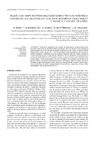Identificador persistente para citar o vincular este elemento:
https://accedacris.ulpgc.es/jspui/handle/10553/106392
| Campo DC | Valor | idioma |
|---|---|---|
| dc.contributor.author | Riera, R. | en_US |
| dc.contributor.author | Rodríguez, M. | en_US |
| dc.contributor.author | Ramos, E. | en_US |
| dc.contributor.author | Monterroso, Ó. | en_US |
| dc.contributor.author | Delgado, J.D. | en_US |
| dc.date.accessioned | 2021-04-05T11:02:07Z | - |
| dc.date.available | 2021-04-05T11:02:07Z | - |
| dc.date.issued | 2013 | en_US |
| dc.identifier.issn | 0240-8759 | en_US |
| dc.identifier.uri | https://accedacris.ulpgc.es/handle/10553/106392 | - |
| dc.description.abstract | Pressure by human activities is one of the main concerns in coastal ecosystems. Port areas harbour heavily modified benthic assemblages. However, there is scarce information about responses of diverse and patchy benthic communities in the context of marine harbour infrastructures (dykes, groins, etc.) which remain inactive after construction. We studied the benthic macrofaunal assemblages on rocky substrates (epifauna) and sandy seabeds (infauna) in a harbour of Gran Canada (Canary Islands, NE Altantic Ocean). We found that both patches of macroalgae (hard substrata) and Cymodocea nodosa seagrass meadows (soft substrata) maintained a highly diverse macrofauna in this inactive harbour. The abundance of individuals and species richness was higher in hard bottoms than in soft bottoms. Species richness showed no consistent changes between both seabeds. However, sampling stations located at higher distances and depths from the dock were proportionally the most diverse, suggesting a distance-effect independently of port infrastructure activity. | en_US |
| dc.language | eng | en_US |
| dc.relation.ispartof | Vie et Milieu | en_US |
| dc.source | Vie et Milieu [ISSN 0240-8759], v. 63, n. 1, p. 23-34 | en_US |
| dc.subject | 240119 Zoología marina | en_US |
| dc.subject.other | Benthos | en_US |
| dc.subject.other | Environmental impact | en_US |
| dc.subject.other | Hard bottoms | en_US |
| dc.subject.other | Soft bottoms | en_US |
| dc.subject.other | Polychaeta | en_US |
| dc.subject.other | Amphipoda | en_US |
| dc.title | Hard and soft-bottom macrozoobenthos in subtidal communities around an inactive harbour area (Gran Canaria, Canary Islands) | en_US |
| dc.type | info:eu-repo/semantics/article | en_US |
| dc.type | Article | en_US |
| dc.identifier.scopus | 2-s2.0-84888108461 | - |
| dc.contributor.orcid | #NODATA# | - |
| dc.contributor.orcid | #NODATA# | - |
| dc.contributor.orcid | #NODATA# | - |
| dc.contributor.orcid | #NODATA# | - |
| dc.contributor.orcid | #NODATA# | - |
| dc.description.lastpage | 34 | en_US |
| dc.identifier.issue | 1 | - |
| dc.description.firstpage | 23 | en_US |
| dc.relation.volume | 63 | en_US |
| dc.investigacion | Ciencias | en_US |
| dc.type2 | Artículo | en_US |
| dc.identifier.external | 12829619 | - |
| dc.description.numberofpages | 12 | en_US |
| dc.utils.revision | Sí | en_US |
| dc.date.coverdate | Marzo 2013 | en_US |
| dc.identifier.ulpgc | No | en_US |
| dc.contributor.buulpgc | BU-BAS | en_US |
| dc.description.sjr | 0,259 | |
| dc.description.jcr | 0,5 | |
| dc.description.sjrq | Q3 | |
| dc.description.jcrq | Q4 | |
| dc.description.scie | SCIE | |
| item.grantfulltext | open | - |
| item.fulltext | Con texto completo | - |
| crisitem.author.dept | GIR ECOAQUA: Biodiversidad y Conservación | - |
| crisitem.author.dept | IU de Investigación en Acuicultura Sostenible y Ec | - |
| crisitem.author.dept | Departamento de Biología | - |
| crisitem.author.orcid | 0000-0003-1264-1625 | - |
| crisitem.author.parentorg | IU de Investigación en Acuicultura Sostenible y Ec | - |
| crisitem.author.fullName | Riera Elena, Rodrigo | - |
| Colección: | Artículos | |
Citas SCOPUSTM
10
actualizado el 08-jun-2025
Visitas
75
actualizado el 23-ene-2024
Google ScholarTM
Verifica
Comparte
Exporta metadatos
Los elementos en ULPGC accedaCRIS están protegidos por derechos de autor con todos los derechos reservados, a menos que se indique lo contrario.
